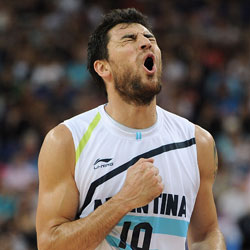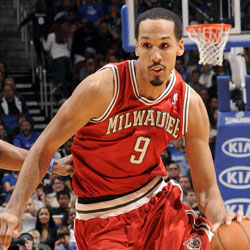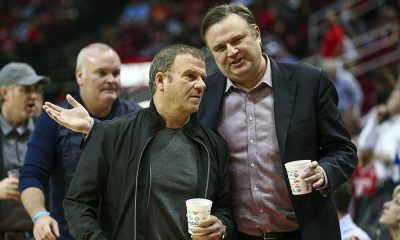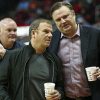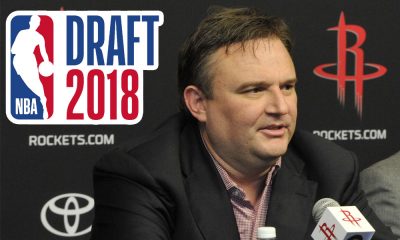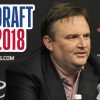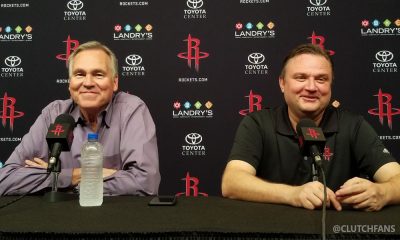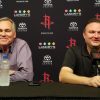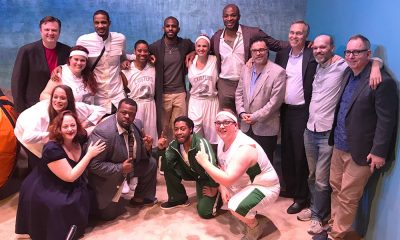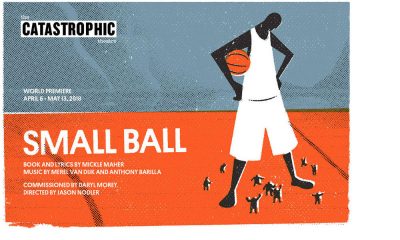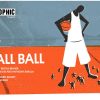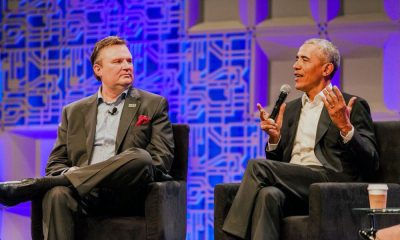Houston Rockets
Houston Rockets Salary Cap Update: 2012-13 Training Camp Edition
With the Houston Rockets opening training camp in advance of the 2012-13 NBA season, let’s take a look at the team’s current salary cap situation.
Published
13 years agoon
With the Houston Rockets opening training camp in advance of the 2012-13 NBA season, let’s take a look at the team’s current salary cap situation.
The Rockets’ Latest Moves
Since my last update, the Rockets have made the following roster moves:
- The Rockets signed Carlos Delfino in mid-August to a two-year deal paying him $3 million next season with a non-guaranteed $3 million salary for the 2013-14 season.
- The Rockets waived Josh Harrellson (on August 15) and Sean Williams (on August 29), whose salaries would have become fully guaranteed had they not been waived at those times.
- On September 7, the team signed Scott Machado to a three-year deal for the league minimum salary, with the first year 50% guaranteed.
- The Rockets waived Diamon Simpson.
- On September 25, the team waived Courtney Fortson and signed guards Demetri McCamey and Kyle Fogg (presumably to non-guaranteed league minimum contracts).
The Trade That Wasn’t
Conspicuous by its absence from the list above is a major trade for You Know Who. For some reason, the ownership and top management of the Orlando Magic felt that Arron Afflalo was a future multiple-time All-Star and that Maurice Harkless (a player the Magic scouted heavily before the draft) was a top-10 talent from this year’s draft class. In their attempt to push the league’s best center out of the Eastern Conference (something that could have just as easily been accomplished by trading him to the Rockets), the Magic instead ushered the league’s second-best center into the Eastern Conference, allowing Andrew Bynum to go to the Sixers in the four-team monstrosity that most pundits claim benefited every team involved except the Magic.
Instead of the lottery-level draft picks, young talent and cap flexibility that the Rockets’ trade offer(s) could have provided the Magic, Orlando instead is left with some comparable young talent but also some bloated contracts (Afflalo and Al Harrington) and a plethora of future picks almost guaranteed to be at the back-end of the first round.
As a result of that trade, the Lakers are back to “top title contender” status and the Rockets are back to the drawing board.
Salary Commitments and Potential Cap Room
(DISCLAIMER: With 20 players currently on the roster, one can be assured that further roster moves will be made, since the regular season roster must contain no more than 15 players. The figures below do not represent the Rockets’ true cap situation once such additional moves are made; they are solely intended to give you a picture of the Rockets’ current cap situation. All salaries courtesy of ShamSports.com.)
Barring any further roster moves, the Houston Rockets now have approximately $55.58 million in team salary for the 2012-13 season: Kevin Martin ($12.44 million), Jeremy Lin ($8.37 million), Omer Asik ($8.37 million), Shaun Livingston ($3.5 million, only $1 million of which is guaranteed), Delfino ($3 million), Patrick Patterson ($2.10 million), Toney Douglas ($2.07 million), Jeremy Lamb ($2.02 million), Marcus Morris ($1.91 million), Royce White ($1.65 million), Gary Forbes ($1.5 million), Terrence Jones ($1.49 million), Donatas Motiejunas ($1.36 million), JuJuan Johnson ($1.09 million), Jon Brockman ($1 million), Chandler Parsons ($888,250), Greg Smith ($762,195, of which 50% is guaranteed), Machado ($473,604, of which 50% is guaranteed), McCamey ($473,604, non-guaranteed), Fogg ($473,604, non-guaranteed), and the cap hit from the Derek Fisher buyout ($644,005; more on that here).
[ShamSports.com shows that the Rockets also owe E’Twaun Moore $381,098 (50% of his 2012-13 salary), supposedly the product of a renegotiation of his contract with Boston prior to the Courtney Lee sign-and-trade deal in which the Rockets acquired him. However, according to a source familiar with the Rockets’ salary cap situation, the Rockets are not paying Moore; hence, I am disregarding this salary for purposes of my own cap calculations. Even if ShamSports.com is correct about Moore, though, the acquisition of the Charlotte Bobcats’ 2013 second round pick from Boston was well worth the small incremental loss of cap space.]
Based on this season’s maximum salary cap of $58.044 million, unless the Rockets make another trade or sign another free agent, they will have at least approximately $2.47 million in salary cap room entering the season (or about $2.09 million if they do, in fact, take a cap hit on Moore). This assumes that only players whose salaries are fully guaranteed are waived. That is a rather unsafe assumption, however.
[NOTE: Rather than make assumptions on what the Rockets’ cap situation will look like based on the numerous combinations of how the final roster will look, I will reserve any discussion on the Rockets’ available cap room for my next Salary Cap Update once the final regular season roster is set.]
Decisions, Decisions – Part 1: Who To Keep?
Of the 20 players under contract with the Rockets, 18 of them are owed at least some guaranteed money that would count against the cap if they were waived. Of those, 15 players have fully guaranteed contracts.
For a moment, let’s make the rather safe assumption that the Rockets will not be cutting any of their (or at least my) projected starting five (Lin, Martin, Parsons, Patterson and Asik), Delfino and their own 2011 and 2012 first round draft picks (Morris, Motiejunas, Lamb, White and Jones). That leaves nine players fighting for four regular season roster spots.
Of those nine remaining players, Douglas has the most guaranteed money owed and also plays some point guard, a position at which the Rockets are low on experience. Douglas also possesses two skills that the Rockets can really use: perimeter defense and (at least prior to his abysmal 2011-12 season) three-point shooting. Therefore, I think Douglas may be safe and could become a decent bench option as a combo guard and defensive upgrade over Lin and Martin (neither of whom should be getting any votes for the NBA All-Defense Team any time soon).
Forbes, Johnson and Brockman are all young forwards who have at least shown flashes of being able to play in the NBA (with Johnson being a 2011 first round pick by Boston). Each is owed at least $1 million guaranteed. While their games are all different (Forbes is a SF with a bit of range; Johnson is a PF/C with length; and Brockman is an undersized bruiser PF), it is unlikely that all three of them make the regular season roster.
Smith is an intriguing prospect, a 6-10 manchild with the girth and wingspan to play center. He’s guaranteed half of his 2012-13 salary, but that amount ($381,098) is a lot less than what would be owed to any of the above-referenced forwards if they were waived. Still, Smith’s ability to play center (he’s more of a “true 5” than Johnson or Brockman) may help him make the team. It also helps that Smith was successful last season playing with the Rio Grand Valley Vipers, the Rockets’ NBA D-League affiliate, as he would likely be spending more time there next season if he remains a Rocket.
Machado appears to have a fairly decent shot at the third string point guard spot after the recent waiving of Fortson. While McCamey is actually a pretty decent prospect in his own right, Machado may be coming off a more successful season, having led college basketball in assists last season as a senior at Iona. One major advantage that Machado has over McCamey is his contract. Machado is guaranteed about $236,802 (50% of his 2012-13 salary) and is locked up for two additional years at the league minimum salary, none of which is guaranteed. Look for Machado to get the nod over McCamey unless McCamey clearly separates himself during training camp and in the preseason.
Fogg–an undersized SG–has little chance of making the team but could at least bring himself some attention if he plays solid defense during the preseason.
Shaun Livingston: A Case Study in Cap Management
Perhaps the most interesting player on the bubble–at least from a cap management standpoint–is Livingston. A veteran 6-7 point guard capable of defending multiple positions, Livingston certainly brings something to the table to help the Rockets next season. However, his contract makes him either (a) expendable as a training camp cut or (b) a valuable in-season trade asset, depending on how the Rockets look at it.
If Livingston were waived prior to the start of the regular season, the Rockets would open up an additional $2.5 million in available cap room. On the other hand, if there is nothing imminently available for which that cap room would be needed, it could make more sense for the Rockets to hang onto Livingston and his contract.
First off, Livingston is probably one of the 15 most useful current Rockets players, so his inclusion on the regular season roster could at least contribute somewhat to some on-court success and/or the development of some of the younger guards. But perhaps just as importantly to this Rockets franchise in transition, Livingston’s contract–which contains no guarantee date–can be used during the season as a trade asset until it finally becomes guaranteed on January 10. Rather than opening up $2.5 million in extra cap room for trades by waiving him, the Rockets could instead take on as much as $4.35 million in additional guaranteed salary by trading Livingston.
Let’s say the Rockets make another move or two using their remaining cap room and perhaps even use the $2.5 million “Room” Exception to add a veteran free agent. They could later use Livingston’s contract to acquire a player making $5.35 million (or more, if the Rockets included other salaries in the deal), with the other team then able to waive Livingston and only pay him $1 million.
With all that said, the Rockets’ current cap situation may dictate that it’s simply not worth it to keep Livingston on the roster.
Unless the other team is gaining significant savings with a trade involving Livingston, it is likely that the Rockets would need to throw in at least $1 million in cash (or perhaps a future second round pick) in order to offset Livingston’s partial guarantee. My guess is that Rockets GM Daryl Morey would prefer to hang onto as much of his $3.1 million “Maximum Annual Cash Limit” (the maximum that teams can include in all trades combined during the 2012-13 season) for either a blockbuster trade for a star player or a draft day trade.
For all the potential benefits of keeping him around, the additional cap room–plus the additional young player who could be kept on the roster–may simply be more valuable to the Rockets than holding onto Livingston the Trade Asset.
Decisions, Decisions – Part 2: Exercise of Rookie Scale Contract Options
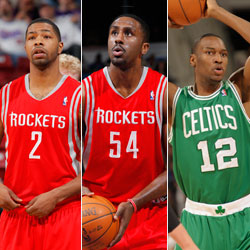
The Rockets will need to decide soon whether to exercise their team options for 2013-14 on Morris, Patterson and Johnson.
Which 15 players make the final regular season roster is not the only decision that Rockets brass will need to make during the month of October. They will also need to make longer-terms decisions on the futures of Patterson, Morris and Johnson, each of whom is a former first round pick who is at least one year in to his rookie scale contract. Patterson’s fourth-year team option (for just under $3.11 million) and Morris’s ($1.99 million) and Johnson’s ($1.14 million) third-year team options must be exercised by October 31.
The decision on Patterson seems like an easy one. Despite a lackluster second year, Patterson shows promise as a young big who can defend both down low and on the pick-and-roll. And based on reports out of offseason workouts, he is developing his post-up game, which was one of the key skills he possessed coming out of Kentucky in 2010 that caused the Rockets to rank him so high on their draft board. The team expects bigger things from Patterson this season, and they are likely willing to bet on him being worth his 2013-14 salary even before seeing whether he achieves any of their goals for him.
Morris has a lot to prove during training camp. Lauded by management a year ago as a poor man’s Carmelo Anthony (a “big 3” who can create his own shot and take advantage of either bigger or smaller defenders with his diverse set of offensive skills), Morris was a disappointment last season. While an ankle injury derailed a nice run he was having with the RGV Vipers, he also seemed to sulk at times over his lack of playing time and his being sent to the D-League during the season. In fairness to Morris, however, the lockout-shortened season and the Rockets’ salary cap balancing act provided little training camp or practice time for him to work on his transition from power forward to small forward, something that few young players can easily accomplish. Given where he was drafted and the relatively small price tag, it would be somewhat surprising if the Rockets did not pick up Morris’s option.
Perhaps one of the more interesting decisions to be made is with Johnson. A defensive stalwart out of Purdue in 2011, Johnson spent a year glued to the bench in Boston, learning his craft from one of the all-time greats at his position (Kevin Garnett). Most reports out of Boston were that the Celtics really didn’t want to part with Johnson but were forced to in order to acquire Lee from Houston. Unfortunately for Johnson, he joins a roster replete with power forwards. Even if he can manage to make the final cut for this season, he will need to truly impress the Rockets in training camp–and show that he is capable of playing multiple positions–in order for the team to commit to a guy who might not be more than the sixth big man on the 2013-14 roster.
Conclusion
With the utter disappointment of failing to acquire a superstar this offseason giving way (for many) to cautious optimism about the long-term potential for this young Rockets team (if not outright relief that The Dwightmare is over), Rockets fans can once again move forward. And despite being spurned yet again in their pursuit of a star player, the Rockets are still well-positioned to make a move if/when another star “shakes loose” (as Morey would say).
With a roster deep (if not top-heavy) in talent, there will be some interesting training camp battles this year. The Rockets are hopeful that such competition will only further improve their plethora of young players.
Bonus Footage
Here is my kid. He is smart. (Sorry, couldn’t resist.)
>> Comments
Houston Rockets
Looking Back on the Trade for Phoenix’s Draft Picks
Are the Rockets set to cash in on Phoenix’s downfall or could a Suns retool murky the waters?
Published
3 weeks agoon
March 12, 2025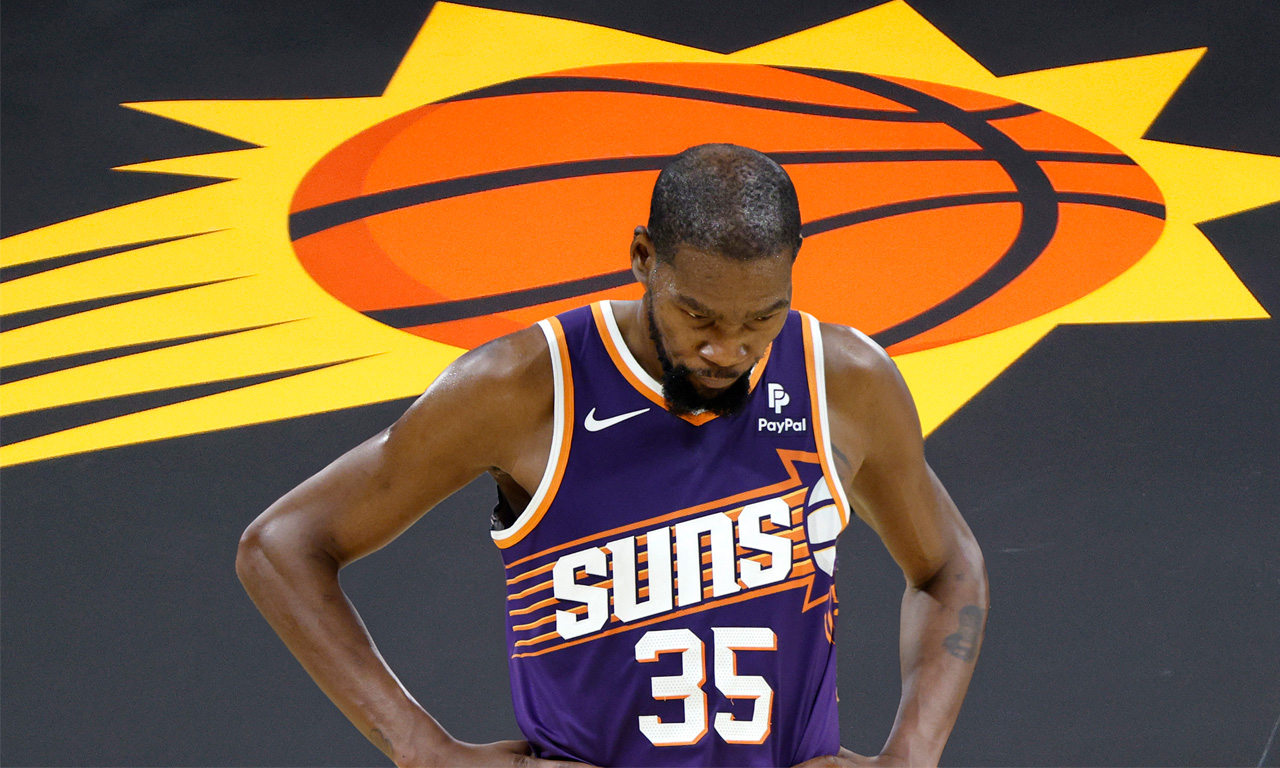
As the Houston Rockets set to host the Phoenix Suns tonight, it seems the right time to take a look back at the trade that linked these two franchises together for the foreseeable future.
This past June, the Rockets made a trade with Brooklyn that sent back to the Nets control of their 2025 and 2026 unprotected first-round picks. In exchange, the Rockets received a large chunk of Phoenix’s future (2025, 2027, 2029) and control of the Dallas Mavericks’ 2029 first.
In essence, the Rockets traded one pick and one swap for two picks and two swaps. All unprotected.
Thoughts At The Time of the Trade
If I’m going to discuss the current outlook of this trade, I have to be honest about how I saw it at the time of the move. While I didn’t hate this trade initially, I definitely didn’t love it either.
I liked that the Rockets increased their overall trade assets. I also liked that they extended the timeline to be able to make a bigger trade and I also appreciated that they kept control of the 2027 Brooklyn swap.
But I didn’t like that the Rockets gave up what seemed like the more established value (Brooklyn) for a more uncertain gamble (Phoenix). The Rockets did not control a “tanking runway” of picks to offer back to Phoenix — all of the picks Houston got in the deal were in staggered years (’25, ’27, ’29). I also felt Brooklyn, who badly needed to rebuild, got away with paying market value to get their picks back despite the fact that the Rockets invested years in watching those picks appreciate up to the point that they had the Nets completely over a barrel.
Net-net: I felt like more certainty was traded for less certainty and it was more of an equitable trade for both teams rather than Brooklyn paying dearly to get back the things only the Rockets could offer.
There were two ways I thought this trade could pay dividends: The Suns needed to flame out immediately, as in this season (unlikely), or the Rockets could trade all those pick assets as part of a deal for a real superstar in the next 12-18 months (more likely).
In a testament to how quickly change can occur in a very unpredictable NBA, four things have happened that have been positive indicators for the Rockets in making this move.
The Suns are fading
While Phoenix had major salary cap issues, dealing with the second apron, they didn’t appear to have problems on the court. They jumped out of the gate 8-1 and looked like a legitimate contender behind their star trio of scorers in Kevin Durant, Devin Booker and Bradley Beal.
Given Houston controlled Phoenix’s pick this year via a swap, it looked like the Rockets would come up empty-handed on the trade this season.
That changed quickly.
Injuries, serious depth concerns and a lack of a defensive identity has sent Phoenix spiraling. Booker’s availability has been inconsistent, forcing Durant to carry the load, while Beal has not quite fit in at all. Their financial limitations, thanks to owner Mat Ishbia’s all-in spending spree, have handcuffed their ability to improve the roster around the three stars.
The Suns are sitting 11th in the West, having gone 22-34 since that hot start, and are currently trying to catch a depleted Dallas squad to get back into the play-in picture.
As of right now, the Rockets project to end up with a lottery pick (albeit a late one) this season out of the trade.
Phoenix was caught shopping Durant
Because the Suns struggled so hard after the start, they tried to make a major move at the deadline but could not unload Beal, in large part due to his no-trade clause.
As a result, they may have made a misstep: They openly tried to trade Durant, which inevitably became public news.
Now? Durant will almost assuredly be traded this summer — likely to a destination that he handpicks. This means the Phoenix Suns will have to look at all possibilities for their future, including potentially having to give Rafael Stone and the Rockets front office a call.
But keep in mind, the Rockets can not offer Phoenix the ability to completely rebuild via the draft right now. Phoenix’s 2026 pick is controlled by Washington. They would have to get extremely creative to set that stage. A retool in Phoenix is much more likely.
Could Brooklyn have been better than expected?
This one is tougher to gauge.
The Brooklyn Nets are currently tied for fifth-worst team in the league, giving them strong lottery odds this summer. This was expected. After all, the Nets, even with a healthy Mikal Bridges and a full roster, were not a good team last season, closing the year 20-41 in the final three quarters of the season. The Rockets ended up with the #3 pick (Reed Sheppard) as a result of Brooklyn’s mediocrity.
However, if the Rockets had not placed that pick back in Brooklyn’s hands, would the Nets be better than this?
Brooklyn brought in a new coach in Jordi Fernandez that has had a positive impact. They have dumped off players, such as Dennis Schroeder and Dorian Finney-Smith, that impacted winning. The bar to make the play-in in the East (.415 winning percentage) is obscenely low, with Brooklyn being just five wins away from it at the moment.
And on top of that, Brooklyn did have lots of draft capital that they could have moved to try to win now.
It’s very tough to say as you don’t know if a team with Bridges still in Brooklyn might have actually been worse than this current squad, but you could make a case that the pick the Rockets would have ended up with from Brooklyn this season would be eerily similar to the one they will end up getting from Phoenix this year.
Again, this is a tough call.
Nico Harrison Hooked the Rockets Up
As part of the trade, the Rockets got control of the Dallas Mavericks’ 2029 first-round pick (unprotected, of course). While there’s really no way of knowing what a pick will be five years out, we did know that Luka Doncic would be just 29-30 years old that season and it was fairly etched in stone that he would be the core piece of a Dallas squad that season.
Enter chaos in Dallas.
Doncic was shipped out in the trade that shocked the world, which could have a major impact on the Rockets. Dallas’ current core of Kyrie Irving and Anthony Davis will be 37 and 36 years old that season, respectively.
On paper, the value of that pick shot up.
Final Summary
Right now, the outlook on these picks looks strong. One source stated off the record that they feel the 2029 Phoenix pick is the best pick asset out there that is owned by another team. The Rockets would be reluctant to add that one specifically into any trade unless it’s for a truly legitimate star.
But if there is any lesson that the NBA teaches us over and over again, it’s that it’s very hard to predict where a team will be a year from now, much less three years from now.
Can the Rockets pressure Phoenix and leverage the ownership they have of their draft capital to get what they really want (Booker) from them? Could a Suns retool around Booker and Beal, with the right pieces and assets acquired from a Durant trade, significantly change their on-court outlook and cap sheet — which in turn could damage the value of the picks Houston controls?
Bottom line is it has worked out well this season, and the future forecast at the moment is promising. The current value of those future picks appears strong. What will likely determine history’s final grade for this trade will be how it sets them up for the trade to come, and that’s where fans will be looking to Stone and the front office for action starting this summer.
Houston Rockets
Amen Thompson’s ankle injury will be re-evaluated in one week
“The things he does you can’t replicate,” says Rockets coach Ime Udoka
Published
3 weeks agoon
March 10, 2025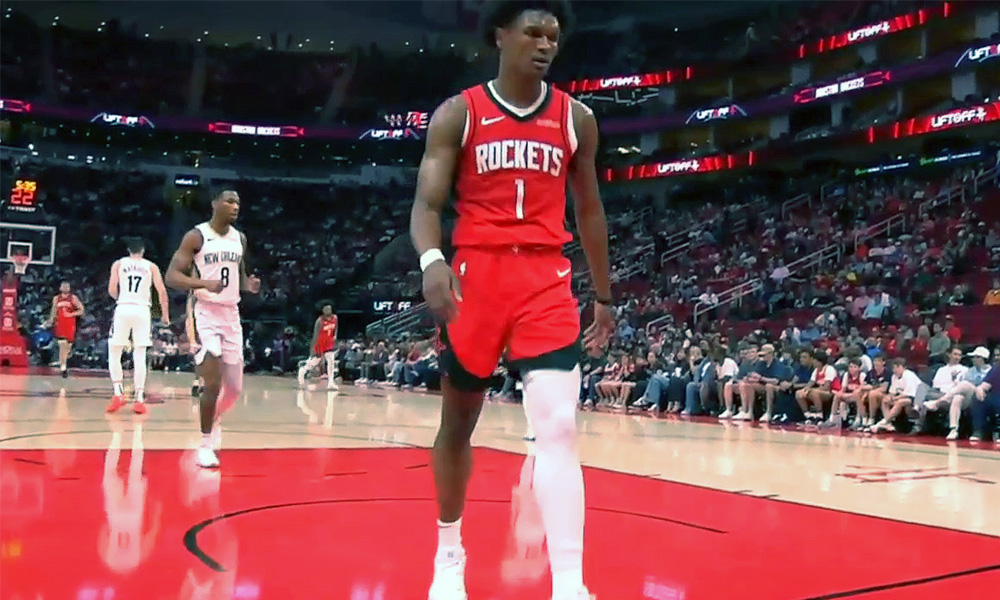
Rockets young star Amen Thompson will have his ankle injury re-evaluated in one week, according to Ime Udoka.
Thompson had an MRI on Sunday and the Rockets coach confirmed all imaging (X-ray, MRI) was negative.
“Just some swelling and pain, obviously,” said Udoka.
If you listen to Udoka, you can tell he knows how special Amen is to this team. He said the Rockets are missing a lot by not having him out there.
“Obviously, the things he does you can’t replicate,” said Udoka. “[Amen is] a guy that plays every position for us. When one goes down, he runs the point. If another is out, he runs the four.”
Amen is one of the best defensive players in the game, and as a one-on-one defender of guards/wings, he might already be the best in the league in just his second season. He’s holding his opponents to 40.5% shooting from the field, tops in the league.
“He’s a very unique defensive player,” said Udoka. “We got some guys that do some great things there, but I like to put him and Dillon on the best two usually, night to night. You got Tari and that’s a luxury as well, but the way he goes about it is different. His athleticism, size, speed, strength, shotblocking ability, steals… he’s all over the place.”
“Hard to replicate for sure.”
Amen injured his ankle late Saturday night in a blowout win against the Pelicans, but the unfortunate part was he probably should not have been on the floor in the first place.
The Rockets left Amen Thompson in the game in a blowout to get one more rebound for a triple-double and he just got injured. He's heading to the locker room with a limp. https://t.co/UBtrEpgWuU pic.twitter.com/D8GeKP8sQk
— ClutchFans (@clutchfans) March 9, 2025
The Rockets had built well over a 30-point lead by early fourth quarter. Jalen Green was able to rest the entire fourth. Alperen Sengun came out of the game with 7-8 minutes left while Dillon Brooks and Tari Eason came out with 6:00 left. But Thompson, who had posted an insane +39 on-off number, remained in the game because he was one rebound shy of a triple-double with 15 points, 11 assists and nine rebounds.
Udoka addressed that decision on Monday before the game against Orlando.
“What I typically don’t do is wholesale substitutions,” said Udoka of the decision to keep Amen in the game. “Albeit 30[-point lead] at six minutes [left] is different than losing to Minnesota, a 16-point lead with four minutes [left].”
“I’ve seen it go both ways in the past. You take out guys too early and have to bring starters back, and vice versa.”
Thompson has played in 60 games this season, five short of being eligible for postseason awards. He absolutely should be up for an All-Defensive nod this season so keep an eye on him getting back in time for that. He would need to return to action no later than April 4th for the game against the OKC Thunder in order to play enough games to be eligible.
Houston Rockets
How the Kyrie Irving Injury Impacts Rockets
Houston’s draft positioning and offseason plans could be impacted by Dallas
Published
1 month agoon
March 4, 2025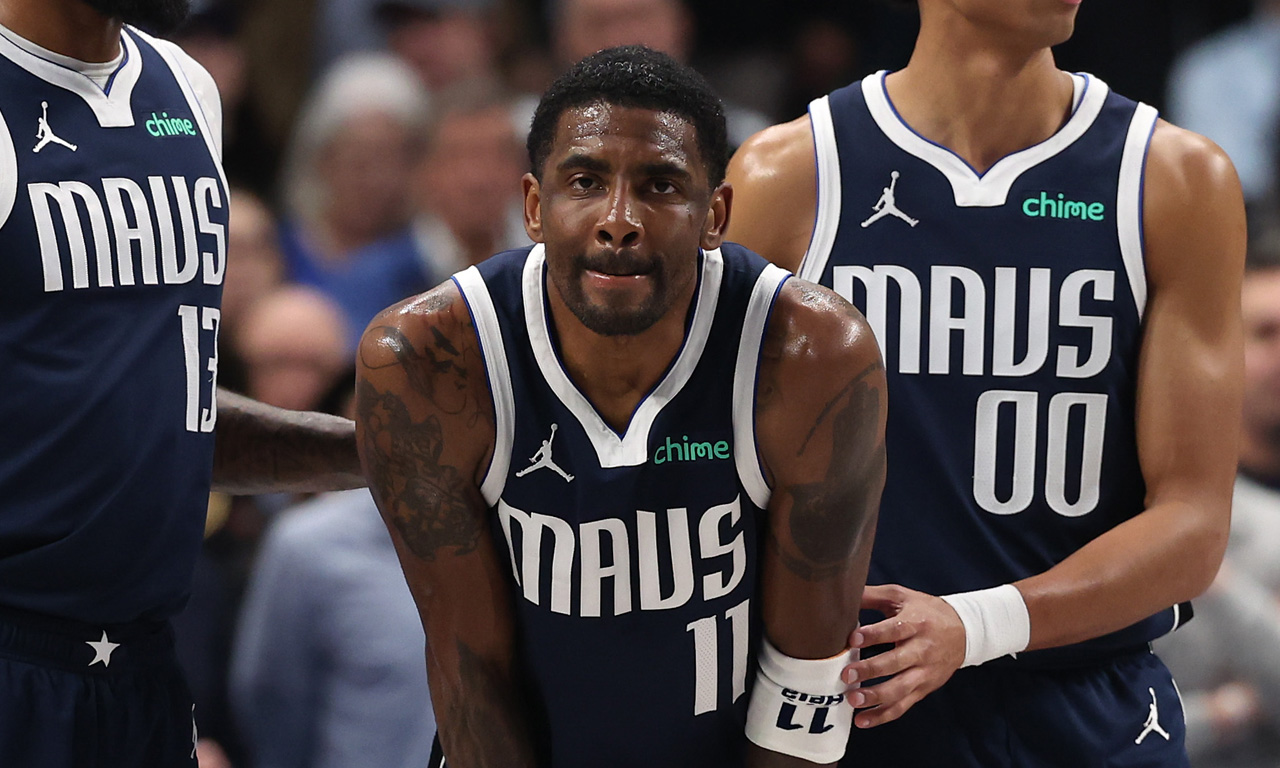
Dallas Mavericks guard Kyrie Irving was injured Monday night and the news dropped on Tuesday that the knee injury is serious — a torn ACL in his left knee that will end his season and a good portion of next season as well.
Brutal. I can’t think of an NBA team that imploded faster than the Dallas Mavericks.
You trade away a 25-year-old phenom who just hoisted you on his back en route to the NBA Finals a year ago. You cashed in that golden ticket to go all-in on a trio of aging stars in Kyrie, Anthony Davis, and Klay Thompson.
Bold strategy, Nico. Let’s see if it pays off.
(Narrator: It’s not paying off.)
The Mavericks had some interesting potential this year and maybe the next couple of years once everyone was healthy, but now? Their star guard is likely out until the calendar year 2026 and Klay and AD aren’t getting any younger nor more durable. The Mavericks may have actually swapped their future for a present that never arrives — and Dallas GM Nico Harrison has to be feeling overwhelming pressure right now.
So how does this impact the Rockets?
For starters, Houston has a game remaining on the schedule against Dallas on March 14th at Toyota Center — Davis may or may not be back for that game.
More importantly, Dallas is the 10th seed in the West at the moment, just 3.5 games ahead of the Phoenix Suns (11th seed). The Rockets control Phoenix’s first-round pick unprotected this season via a swap. We need as many West teams as possible ahead of Phoenix to keep them out of the play-in/playoffs and to push them as deep into the lotto as possible.
This complicates that. Phoenix’s remaining schedule is the toughest in the NBA by a good margin, with plenty of games left against the league’s best teams, so it still looks promising overall — but we’re talking about Kevin Durant, Devin Booker and Bradley Beal. They can still get hot at the right time while Dallas may struggle.
So keep a close eye on that. The good news is the Portland Trail Blazers are one of the hottest teams in the league and they are (shockingly) nipping at the Arizona squad’s heels.
Taking a look ahead to the offseason, the Kevin Durant Pursuit will be big.
This one is a little more complicated for Houston. The Rockets really want Devin Booker but, as of now, the Phoenix plan appears to be to trade KD this offseason and retool around Booker. The Rockets will have interest in Durant but they’re not going to sell the farm (prospects and all the picks) for a 37-year old like they would for Booker.
Three teams that I’ve heard a lot about from Rockets circles that will be in the mix are Houston, Minnesota and Dallas — Timberwolves and Mavericks have been considered the main competition. But, a lot of this will depend on Durant himself and where he wants to play at this stage of his career.
Keep in mind also, if the Suns are “retooling” around Booker and Beal (holding the no-trade clause), then they could be placing a higher priority on win-now players over the return of their own draft assets. The Rockets definitely have the best assets overall to offer up in any trade package between those three teams, but if Phoenix does prefer finding the right ready-to-win players around Booker/Beal, that gives Dallas and Minnesota a real chance.
This injury “may” take Dallas out of the equation, and they are/were definitely a contender for KD’s services given his past relationship with Kyrie and the way Dallas was positioned to win right now. Does KD at his age want to wait for Kyrie to be healthy?
And one last friendly reminder: The Rockets control that Dallas 2029 first (unprotected).
Houston Rockets
Rockets Sign David Roddy to Two-Way Contract
Former first-round pick has played with the Grizzlies, Suns and Hawks
Published
1 month agoon
March 3, 2025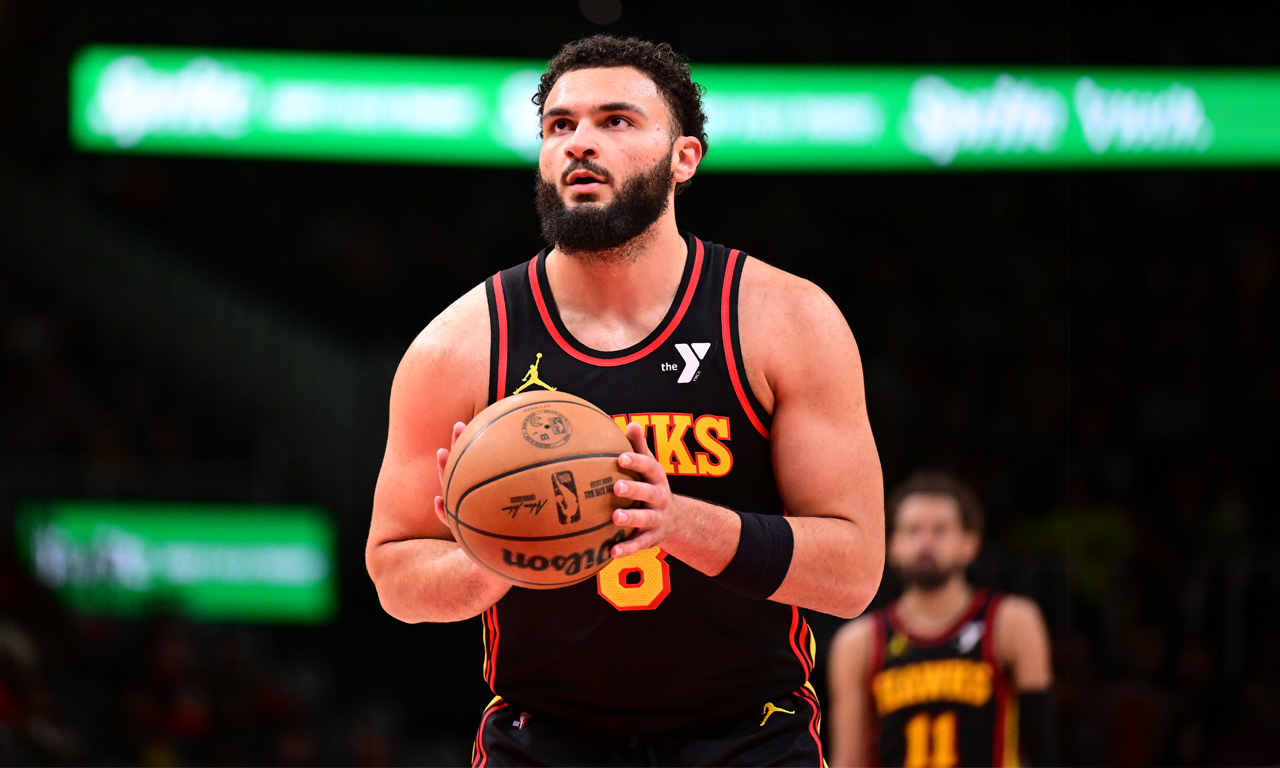
The Rockets made a move on Monday, signing former first-round pick David Roddy to a two-way contract.
The two-way spot opened up after the front office signed Jeenathan Williams to a standard four-year, $8.2 million contract (with friendly team options all along the way).
Roddy is 6-foot-5 and 250+ pounds but sports a 6-foot-11 wingspan. He was taken with the 23rd pick in the first round of the 2022 NBA Draft — six selections after the Rockets drafted Tari Eason. A standout in college, Roddy averaged 19.2 points, 7.5 rebounds, 2.9 assists, 1.2 steals, and 1.1 blocks per game during his junior season at Colorado State.
Roddy, who turns 24 later this month, is a physical player who can play multiple positions. He’s a solid rebounder for his size/position. He has played in 165 games over three seasons with the Grizzlies, Suns, Hawks and most recently Sixers, averaging 6.2 points and 2.9 rebounds per game.
The guard/forward has not shown efficient shooting, however — he’s a career 30.5% three-point shooter and just 68.4% from the line. His defense is better inside than out.
Ultimately, it will be those two things — three-point shooting and defense — that will determine his chances of carving out a consistent role in the league.
All in all, it’s a low-risk signing and the Rockets get a look at a prospect that fits their age timeline.
Houston Rockets
Houston a potential landing spot for Ben Simmons post-buyout?
Published
2 months agoon
February 6, 2025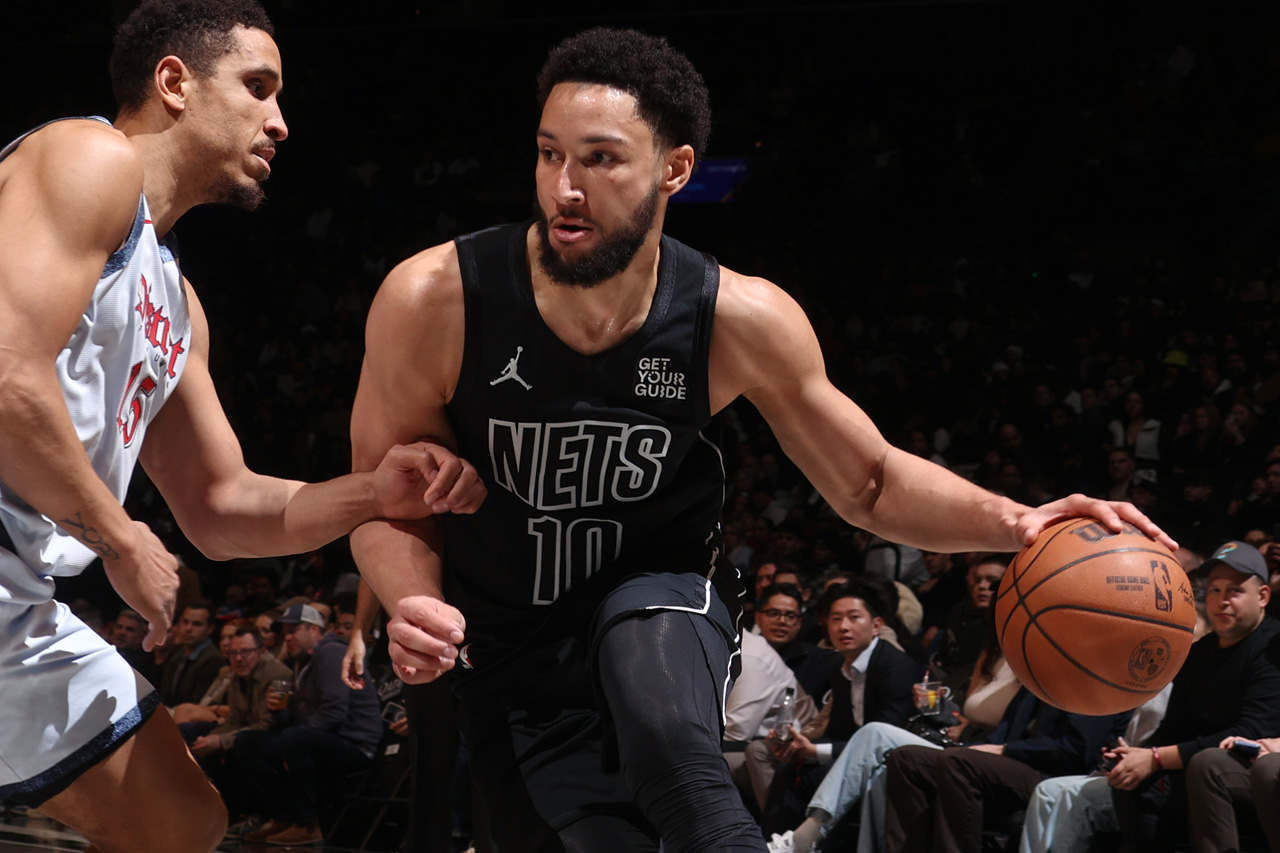
ESPN NBA analyst Brian Windhorst said on Thursday’s NBA Trade Deadline show that Brooklyn Nets forward Ben Simmons is working on a buyout and the Houston Rockets is a potential landing spot for him.
“Cleveland and Houston are two situations for Ben Simmons,” said Windhorst.
Brian Windhorst says the Cavaliers and Rockets are buyout locations for Ben Simmons.
Thoughts? pic.twitter.com/7ly4mvmxr5
— ClutchFans (@clutchfans) February 6, 2025
Advertisement
Rockets coach Ime Udoka was an assistant coach in Philadelphia in 2019-20 when Simmons was with the Sixers, before injuries took a significant toll. In fact, Udoka, when speaking about Amen Thompson earlier this season, brought up some comparisons to Simmons.
“The skill set is there, and it’s something that’s unique with his speed, athleticism, size, passing ability, and all those things,” said Udoka of Thompson. “I coached somebody, Ben Simmons, who had similar traits… as far as size and ability to push the pace, and find guys and finish. There are some similarities there.”
Both Thompson and Simmons are known for their elite athleticism, defensive versatility, and ability to create opportunities in transition.
However, can Simmons help the Rockets today? That’s the tough question.
Simmons has played in 33 games this season, averaging 6.2 points, 6.9 assists, 5.2 rebounds, 0.8 steals and 0.5 blocks in 25 minutes a night. He does not shoot threes (like, at all) — he has only attempted two threes in the past three seasons combined.
Ideally, he does not play in front of your young forwards of Amen, Tari Eason and Jabari Smith Jr. and on that basis alone, I think I would pass. But, Ime loves defensive dogs and he could use some extra ballhandling on the roster. You can see that there’s little in the way of offensive organization when Fred VanVleet is out.
There would be a comical full circle moment though if the Rockets did sign Ben Simmons, considering the Rockets were heavily criticized for trading James Harden in 2021 to Brooklyn instead of to Philadelphia for Simmons. The Rockets clearly made the right choice there.

